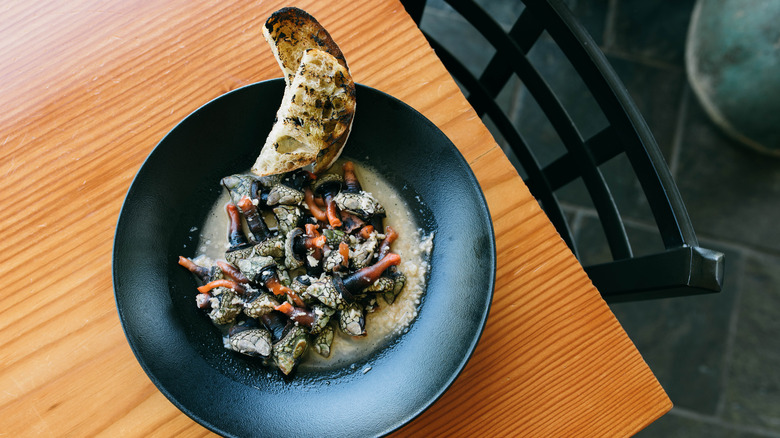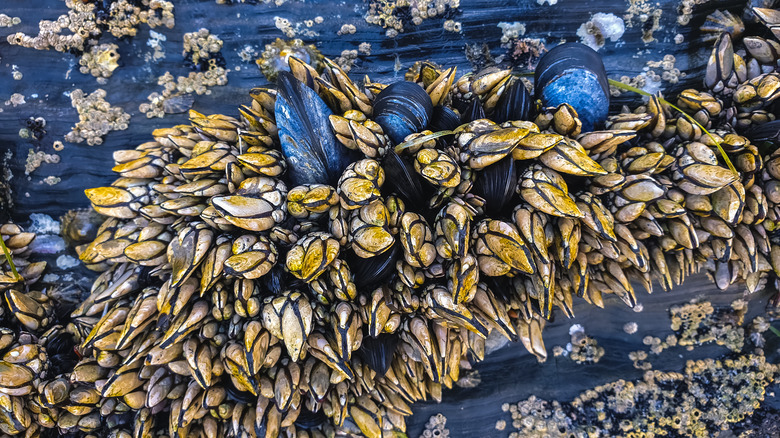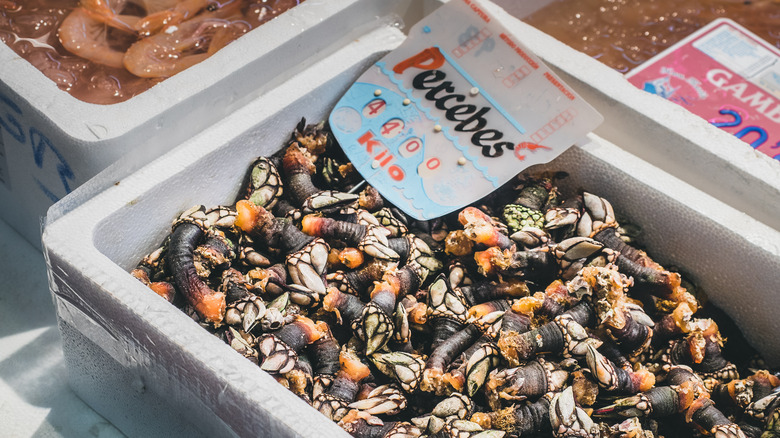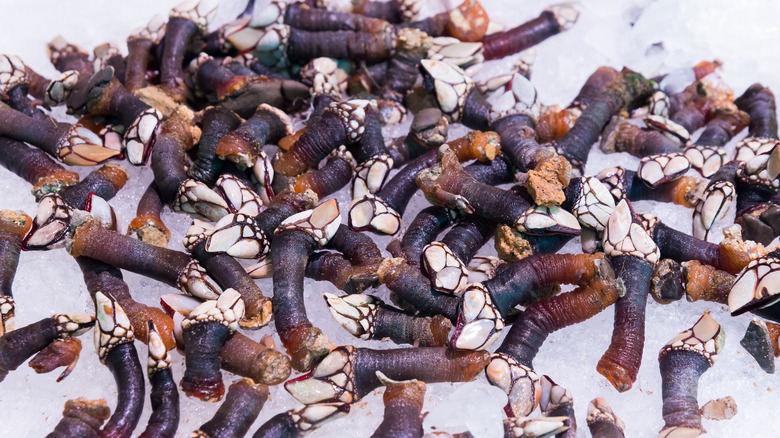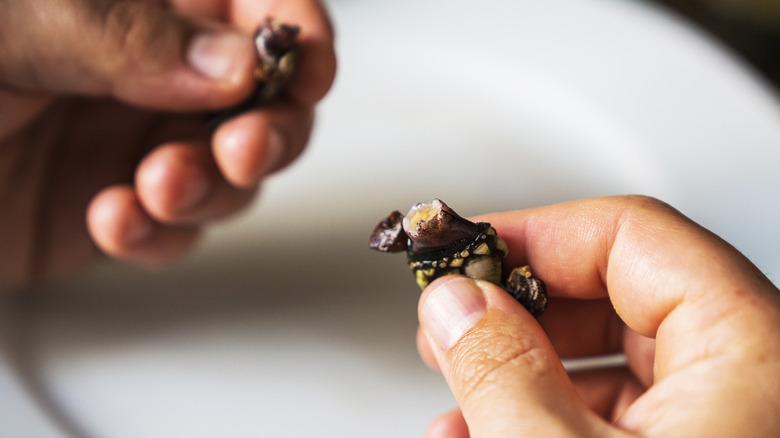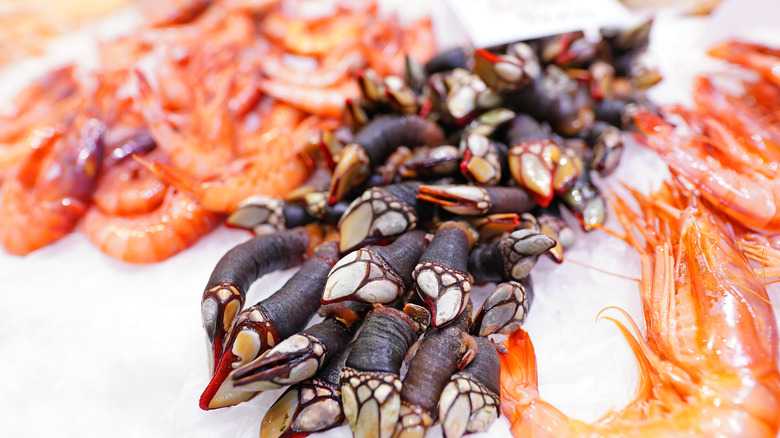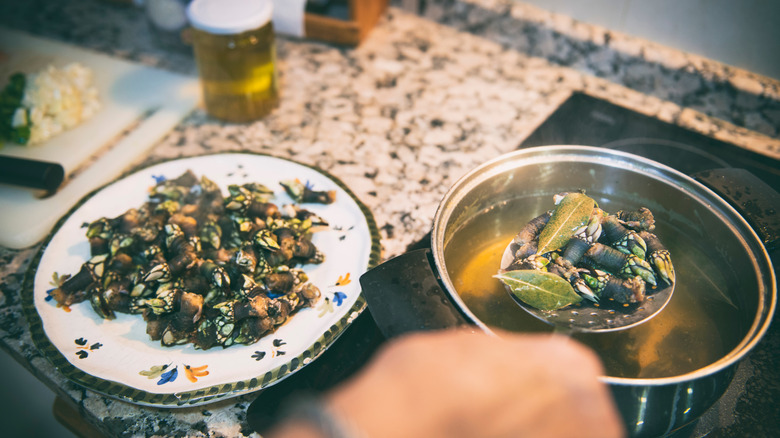What Are Gooseneck Barnacles And Why Are They So Expensive?
Gooseneck barnacles are kind of scary to look at — their alien-like appearance conjures up images from the sci-fi realms of "Star Trek" or "Doctor Who." They're weird, but their oddity and scarcity make them a luxurious delicacy. Gooseneck barnacles, otherwise known as percebes, may look like their cousins that attach to docks, but taste much better, according to Food & Wine.
Per The Wildlife Trusts, this type of animal is considered a crustacean, related to lobsters and crabs. They are filter feeders that are dependent on water movement for feeding. The Nature Niche explains that there are two types of barnacles — those that live in shells and are basically glued onto the surface they decide to inhabit, and those, like gooseneck barnacles, that have stalks and use an antenna-like appendage to attach to rocks and crevices. This delicious ingredient has piqued the imagination of many curious diners, including those who originally named the animal.
What are gooseneck barnacles?
According to Atlas Obscura, gooseneck barnacles got their name centuries ago when medieval naturalists stumbled upon these claw-like sea creatures and thought they were goose eggs. They witnessed the crustaceans fall into the water and believed baby geese emerged fully formed from the dislodged barnacles.
The Nature Niche further corroborates this story, but also offers another origin, suggesting that the name is a result of people thinking that the way the stalk curved and the shape of the claw-like end gave the appearance of a goose's neck and head. CNM VIP Voice credits a 16th century English author named John Gerard for giving the moniker to this animal. Gerard wrote of this seafood, calling them, a "barnakle tree, or a tree bearing geese." With such an evocative name, it is hard not to imagine what this unique seafood tastes like.
Where do gooseneck barnacles come from?
According to CNN, this seafood is among the most expensive in the world and can go for as much as $125 a pound. Toronto Life reports that in Europe, a kilogram of gooseneck barnacles could yield $500. Their price is related to a limited supply and the risk a fisherman must face to obtain this delicacy.
This variety of seafood is most likely to be found off of Spain's Costa da Morte, or Coast of Death, per CNN. This ominous-sounding locale lives up to its name — gooseneck barnacles like to make their home on razor-sharp rocks where the waters are fierce and tumultuous. The more dangerous the spots yield tastier barnacles, making the gathering process of this ingredient that much harder. Gooseneck barnacle fishermen even have their own name — Percebeiros — and have the rare skill of jumping from their boats to these rocks to remove the shellfish and swim through underwater caves to find this commodity (via CNN).
What do gooseneck barnacles taste like?
According to those who have eaten gooseneck barnacles, they are quite tasty. Andrew Zimmern tweeted in 2016, "Foraged gooseneck barnacles, snails, crabs, and limpets. $100 dinner for 10 minutes work," per Twitter. According to the Travel Channel, Zimmern finds this seafood delicious, and he is not alone.
One New York Times reporter shared that the seafood reminded her of crabs, but evokes the taste of scallops to others. She likened the gooseneck barnacle's texture to octopus or the innards of a soft-shell clam. San Diego Food and Travel stated that the shellfish's texture is toothsome with a sweet-and-salty brine. If you can get past the appearance of this strange-looking sea fare, they taste pretty darn good. When you want to send your tastebuds on a journey, make sure to score some of these unique crustaceans for an unforgettable culinary experience.
How to cook gooseneck barnacles
You don't want to mess this seafood up when you cook it, especially considering their high price tag. According to San Diego Food and Travel, you need to eat the long neck of the animal. Preparing this ingredient can be quite simple. If you are going to serve these babies up as part of a tapas spread, as is quite often done in Spain, you can just boil your gooseneck barnacles in salted water, similar to how you would make pasta. When the water comes to a boil, toss in the sea creature and remove it right as the water starts boiling again. Some suggest serving this boiled shellfish with aioli.
When it comes time to eat, hold the gooseneck barnacle by the claw-like toe, remove the black sweater-like wrapping — it should peel right off — and chow down. Seasoned cooks might try pairing this seafood with chorizo and peas. Browne Trading suggests adding the barnacles to your soups and chowders.
Where to buy gooseneck barnacles
Gooseneck barnacles are a rarity, so don't expect to find them in your frozen or fresh fish sections at your local grocery store. According to Food & Wine, this seafood is harvested in the spring and fall in Spain and Portugal, making these seasons the prime time to sample the seafood. If you want to try fresh gooseneck barnacles from Iberia, you may want to check out an online source, like Browne Trading. A trip to Europe may not be economical and for those who want to try the ingredient in North America, you can occasionally find the item fresh in Vancouver. Oregon also contains gooseneck barnacles, which can be found on rocks in this coastal state and are harvested for commercial use, according to the University of Oregon. There are even efforts underway to find a sustainable way to farm this delicacy. If successful, perhaps everyone can enjoy these one-of-a-kind sea creatures.
If you do purchase gooseneck barnacles online, you will need to use them rather quickly. Jonathan Harris, the owner of the Spanish food supply company La Tienda, told Food & Wine that this type of shellfish is shipped alive and can be stored in the refrigerator for a few days. Unfortunately, they cannot be stored in water and must be kept somewhat dry.
Gooseneck barnacles nutrition information
Gooseneck barnacles are strange to look at, but a luxury dish worth trying. According to Fankal, gooseneck barnacles are low in calories, clocking in at just 66 calories per 100 grams. They also note that the ingredient contains 15.7 grams of protein per serving, in addition to 0.4 grams of fat and 0 grams of carbohydrates. A restaurant in Madrid called La Casa Gallega extols the virtue of consuming this seafood, claiming that the ingredient is rich in iodine, selenium, and iron. The nutrition content may change based on how you prepare the barnacles, and this ingredient can fit many diets on its own.
When you crave a new culinary challenge and want to enjoy a rare food, make sure to get your hands on a serving or three of gooseneck barnacles. This exquisite seafood may evoke the creatures found in a sci-fi movie, but their unique flavor can make anyone come back for seconds.
